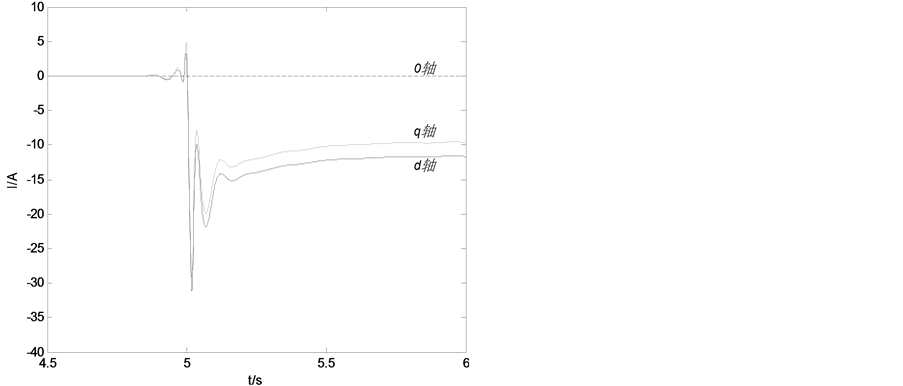Journal of Electrical Engineering
Vol.05 No.02(2017), Article ID:20905,5
pages
10.12677/JEE.2017.52022
Simulation and Analysis of Grid-Connected Control of Micro-Turbine
Hualin Gong1, Chunlin Gao2
1State Grid Chengdu Electric Power Supply Company, Chengdu Sichuan
2School of Electrical and Information Engineering, Southwest Petroleum University, Chengdu Sichuan

Received: May 16th, 2017; accepted: Jun. 6th, 2017; published: Jun. 9th, 2017

ABSTRACT
In this paper, the simulation and modeling of micro-turbine grid-connected system are studied. Selection of integrated control mode for the control of the micro-network and the relevant parameters were set. The simulation results show that the current at the switch K5 (PCC), the output power of each DG output, the reactive power of each DG output, the voltage amplitude on the bus and the frequency of the microgrid system are simulated and analyzed. When the microgrid is incorporated into the main grid, the reason for its inrush current may due to a slight difference between the frequency of the microgrid and the frequency of the mains in the orphan operation. The main power does not only line in the transmission of active power to the micro-grid, but also show that DG2, DG3 using Droop control can be adjusted by the reasonable output power for the micro-grid to provide voltage and frequency support. The Q-U decoupling control in the Droop control (which provides the voltage support for the microgrid), the voltage amplitude of the bus will increase accordingly. Droop control in the P-f decoupling control (the purpose of micro-grid to provide frequency support), the micro-grid system frequency will rise accordingly.
Keywords:Micro-Turbine, Grid-Connected, Integrated Control, Droop Control
微型燃气轮机的并网控制仿真与分析
龚华麟1,高春林2
1国网成都供电公司,四川 成都
2西南石油大学电气信息学院,四川 成都
收稿日期:2017年5月16日;录用日期:2017年6月6日;发布日期:2017年6月9日

摘 要
本文对微型燃气轮机并网系统的仿真与建模进行研究。选用综合控制方式对微网并网进行控制,对相关的参数进行了设定。对开关K5 (PCC)处的电流、各个DG输出有功功率、各个DG输出无功功率、母线上电压幅值、微电网系统频率变化情况进行了仿真分析。仿真结果表明,当微电网在并入到主电网的时刻,其冲击电流的产生,可能是处于孤网运行状态时的微电网频率与主电网的频率之间略有差异等原因造成。主电网在向微电网输送有功功率,同时也说明了由于DG2、DG3采用Droop控制方式,因而可以通过合理地调节输出功率,为微电网提供电压以及频率支撑。Droop控制中的Q-U解耦控制(目的为微电网提供电压支撑),则母线的电压幅值会有相应的增加。Droop控制中的P-f解耦控制(目的为微电网提供频率支撑),则微电网系统频率会相应上升。
关键词 :微型燃气轮机,并网,综合控制,Droop控制

Copyright © 2017 by authors and Hans Publishers Inc.
This work is licensed under the Creative Commons Attribution International License (CC BY).
http://creativecommons.org/licenses/by/4.0/


1. 引言
目前为止,针对DG的控制方式主要包括:PQ控制策略(主要应用在并网运行模式下)、Droop控制和U/f控制策略(主要应用在孤网运行模式下) [1] 。微电网的运行控制方法主要包括:主从控制(master-slave operation)、对等控制(peer-to-peer operation)、综合控制 [2] 。当微网选用主从控制方式(master-slave operation)时,其中主控DG的控制方式选择U/f控制,而从属的DG的控制方式选择PQ控制 [3] 。当微网处于并网运行模式下,全部DG的控制策略均使用PQ控制方式;当在出现故障等情况,微网进入孤网运行模式,此时主控DG的控制方式将迅速变为U/f控制,在为从属DG提供Uref、fref的同时,也承担由负荷变动引起的扰动 [4] 。当微网选用对等控制方式(peer-to-peer operation)时,系统内各个DG之间的关系是对等的,即没有第一种控制方式中的主控、从属的区别 [5] 。微电网的综合控制方式,适用于在一个微网中,含有多个不同类型的DG的情况,对于能够输出比较稳定的电能的MS选用Droop控制方式,对于那些输出为间歇性能源的MS选用PQ控制方式,这种微电网的控制方式可以有效保证输出电能质量的稳定性以及可靠性 [6] [7] 。
本文对微型燃气轮机并网系统的仿真与建模进行研究。选用综合控制方式对微网并网进行控制,对相关的参数进行了设定。对开关K5 (PCC)处的电流、各个DG输出有功功率、各个DG输出无功功率、母线上电压幅值、微电网系统频率变化情况进行了仿真分析。
2. 微网仿真模型搭建
如图1所示的微电网的仿真模型。其各部分的主要参数如表1所示。
3. 微网由孤网运行到并网运行过程分析
3.1. 断路器动作设置
令微电网在0~5 s时处于孤网运行状态,5~10 s时处于并网运行状态。断路器(Breaker)动作设置如表2所示。

Figure 1. Microgrid simulation model
图1. 微电网仿真模型
Table 1. Main parameters of microgrid integrated control model
表1. 微电网综合控制模型主要部分参数
Table 2. Circuit breaker action setting
表2. 断路器动作设置
3.2. 仿真分析
如图2(a)所示为开关K5 (PCC)处的电流仿真结果。如图2(b)所示为各个DG输出有功功率的仿真结果。如图2(c)所示为各个DG输出无功功率的仿真结果。图2(d)所示为母线5上电压幅值的仿真结果。图2(e)所示为母线6上电压幅值的仿真结果。如图2(f)中所示为微电网系统频率变化情况的仿真结果。

 (a) (b)
(a) (b)

 (c) (d)
(c) (d)
 (e) (f)
(e) (f)
Figure 2. Simulation results
图2. 仿真结果
4. 结论
1) 当微电网并入到主电网的时刻,其冲击电流的产生,可能是处于孤网运行状态时的微电网频率与主电网的频率之间略有差异等原因造成的。
2) 主电网在向微电网输送有功功率,同时也说明了由于DG2、DG3采用Droop控制方式,因而可以通过合理地调节输出功率,为微电网提供电压以及频率支撑。
3) Droop控制中的Q-U解耦控制(目的为微电网提供电压支撑),则母线的电压幅值会有相应的增加。Droop控制中的P-f解耦控制(目的为微电网提供频率支撑),则微电网系统频率会相应上升。
文章引用
龚华麟,高春林. 微型燃气轮机的并网控制仿真与分析
Simulation and Analysis of Grid-Connected Control of Micro-Turbine[J]. 电气工程, 2017, 05(02): 179-183. http://dx.doi.org/10.12677/JEE.2017.52022
参考文献 (References)
- 1. 张建华. 微电网运行控制与保护技术[M]. 北京: 中国电力出版社, 2010.
- 2. 石立国. 微网实验系统的分析与设计[D]: [硕士学位论文]. 天津: 天津理工大学, 2013.
- 3. 陈新, 姬秋华, 刘飞. 基于微网主从结构的平滑切换控制策略[J]. 电工技术学报, 2014, 29(2): 163-170.
- 4. 张项安, 张新昌, 唐云龙, 等. 微电网孤岛运行的自适应主从控制技术研究[J]. 电力系统保护与控制, 2014(2): 81-86.
- 5. 李军, 杨志超, 陈凡. S形下垂控制方法在微电网对等控制中的应用[J]. 中国电力, 2014, 47(12): 88-94.
- 6. 牟晓春. 微电网综合控制策略的研究[D]: [硕士学位论文]. 吉林: 东北电力大学, 2011.
- 7. 李培强, 刘志勇, 李欣然, 等. 应用综合控制策略的微电网建模与仿真[J]. 高电压技术, 2011, 37(10): 2356-2362.
